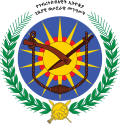| Emblem of Ethiopia | |
|---|---|
 | |
| Armiger | Federal Democratic Republic of Ethiopia |
| Adopted | 1996 (modified 16 May 2009) |
| Shield | Azure, a pentagram with five rays of light or. |
The Emblem of Ethiopia has been in its current form since 1996. It contains a yellow interlaced pentagram radiating rays of light on a blue shield. Today, the pentagram stands for the unity of the people and nationality of the Federal Democratic Republic of Ethiopia. The Emblem appears in the centre of the flag of Ethiopia.
Contents
Prior to 1975, the coat of arms of the Ethiopian Empire was used.
In 1975, an earlier version of the emblem of Ethiopia was adopted, consisting of a plow on a yellow sunburst surrounded by a wreath. It was used until 1987 and eventually became associated with the Derg regime.
Colours scheme
| | Blue | Yellow |
|---|---|---|
| RGB | 15/71/175 | 252/221/9 |
| Hexadecimal | #0f47af | #fcdd09 |
| CMYK | 91/59/0/31 | 0/12/96/1 |









